
Shrubs Around Las Vegas, Vegetation Around Las Vegas
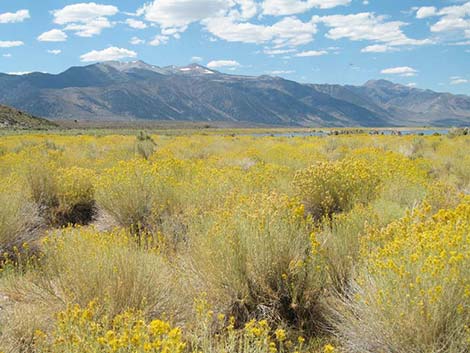 Vast fields of yellow in the Great Basin |
Rabbitbrush species (Chrysothamnus and Ericameria) are upright, usually at least thigh-high shrubs with green stems and small leaves that produce dense, yellow flowerheads at the top of the shrub during fall. These are an odd collection of shrubs because not everything in these two genera is considered a Rabbitbrush species: some are called Golden Bushes. In Nevada, several species of Chrysothamnus and Ericameria are common: In the mountains of southern Nevada, two species of rabbitbrush are common: Rubber Rabbitbrush (Ericameria nauseosa) and Yellow Rabbitbrush (Chrysothamnus viscidiflorus). Rubber is more common in southern Nevada, but farther north, Yellow is more common. In the deserts of southern Nevada, several species are common: Narrowleaf Goldenbush (Ericameria linearifolia) and Turpentine Bush (Ericameria laricifolia) occur in hills and rocky areas, and Mojave Rabbitbrush (Ericameria paniculata) can be abundant in desert washes. In the rocks, Narrowleaf Goldenbush is more common that Turpentine Bush. |
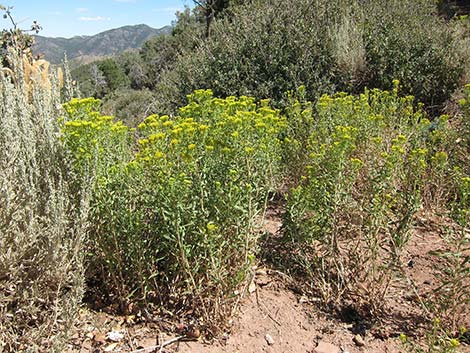 |
Members of the genus Ericameria are separated from those in the genus Chrysothamnus by the presence or absence of dense, woolly hairs on the stems (Ericameria has them). In general, Ericameria has phyllaries arranged in spirals, whereas Chrysothamnus has phyllaries arranged in vertical ranks. Rabbitbrush often are a common component of vegetation communities from the lower elevation the Lower Sonoran (Mojave Desert Scrub) life zone to the Transition (Yellow Pine Forest) life zone. Some Rabbitbrush species thrive in disturbed areas, so keep an eye out along roadsides such as those on Mt. Charleston (Rubber Rabbitbrush). Family: Sunflower (Asteraceae). |
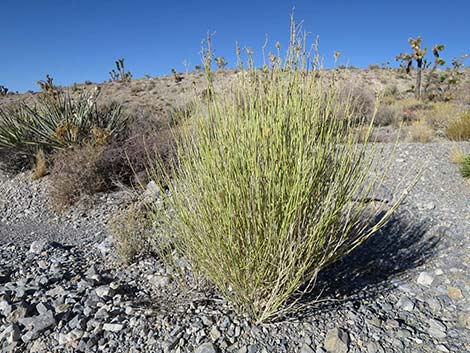 |
Other Names: Each species has a common name. Plant Form: Upright shrub with many, green stems Height: Usually knee- to waist-high, occasionally head-high. Bark: New bark is green; older bark is light gray. Stems: Erect. Leaves: Narrow (to 3 inches long and 1/3 inch wide), green. |
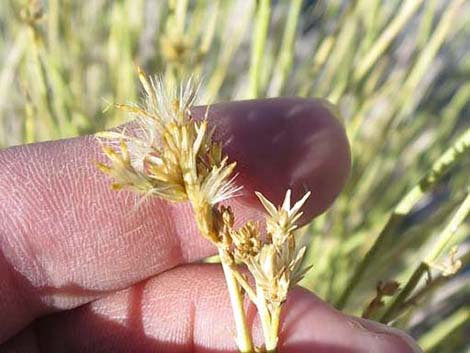 |
Flowers: Blooms in the fall. Inflorescence: many dense heads of tiny yellow flowers, sometimes covering the entire top of the shrub. Ripens to brown, fluffy flowerheads atop the plant. Seeds: Small, hairy achene (like a tiny sunflower seed). Habitat: Sandy and gravelly soils in and along washes. Elevation: 3,000 to 10,000+ feet Distribution: Western North America from British Columbia to Baja California. Comments: |
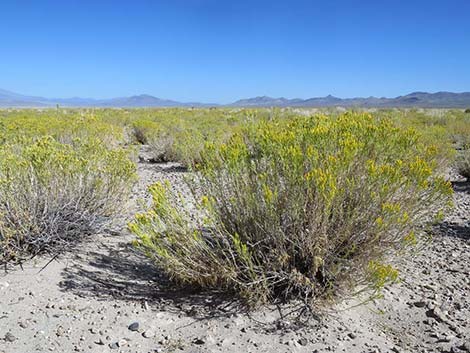 |
Yellow Rabbitbrush (Chrysothamnus viscidiflorus). A medium-sized, upright shrub. The fresh stems are green, and the leaves often are twisted. The leaves are linear to lanceolate, to 75-mm long and 10-mm wide, and they have a visible mid-vein and two or four side veins. During fall, sticky clusters of yellow flowers are produced above the leaves at the ends of the stems. Typically, the phyllaries unequal in length and ranked vertically to form a cylinder, but they are variable and can spiral and hairy or not. |
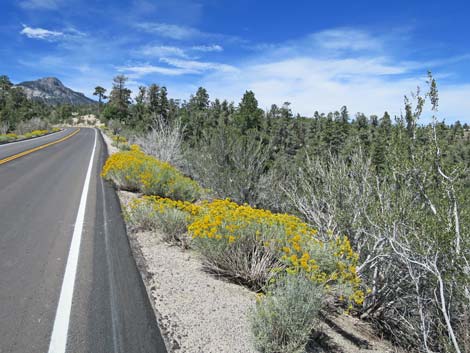 |
Rubber Rabbitbrush (Ericameria nauseosa). A large, upright shrub. The fresh stems and leaves are densely hairy (felt-like). The leaves are long, linear, and lack resin pits. During fall, clusters of yellow flowers are produced at the ends of the stems. The flowerheads are composed only of disk flowers. The phyllaries are of unequal length in several series, but aligned vertically. Sometimes there is a strong odor. |
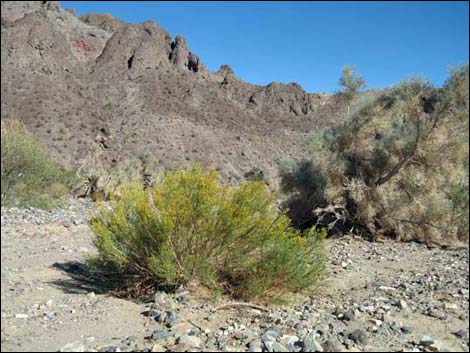 |
Mojave Rabbitbrush (Ericameria paniculata). Previously called Black-banded Rabbitbrush, is an upright, usually waist-high shrub with green stems and thread-like leaves dotted with resin-filled pits. During fall, the plants produces dense, yellow flowerheads at the top of the shrub. The flowerheads have only disk flowers, and the phyllaries are unequal in length. The phyllaries are also thin, and the mid-vein is often evident but not raised or enlarged at tip. |
Golden Bushes
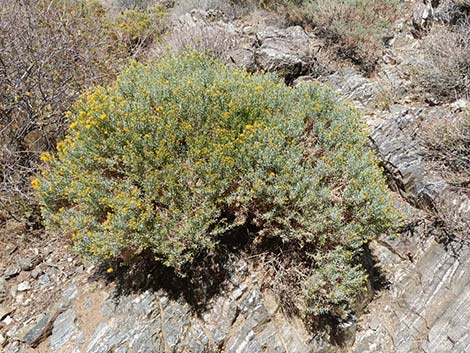 |
Turpentine Bush (Ericameria laricifolia). One of the Golden Bushes. A mid-sized, rounded shrub with thickened leaves that are resinous with glands in pits. The stems and leaves are glabrous, gland-dotted and resin-coated, resinous, and aromatic. Leaves are elongate, but variable in width (threadlike to oval). Phyllaries are set series of 2-7, resinous, and persistent. Disk flowers few to many (6-18). Ray flowers few (3-6). Clusters of yellow flowers are produced at the tips of the branches during spring and early summer. It seems that the flowers open with only disk flowers, but then ray flowers emerge later. |
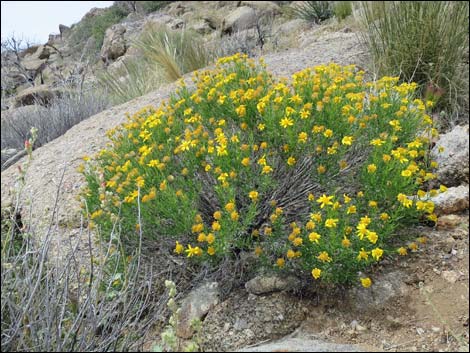 |
Narrowleaf Goldenbush (Ericameria linearifolia). One of the Golden Bushes. A large, upright shrub with long, narrow leaves. Clusters of yellow flowers are produced at the ends of the branches during spring and early summer. Leaves to 2 inches, linear, narrow at base. Involucre wide (to 18 mm) and long. Phyllaries elongate, in 2–3 series. |
Note: All distances, elevations, and other facts are approximate. Names generally follow the USDA database.
![]() ; Last updated 250706
; Last updated 250706
| All Shrubs | Plant Species Index | Glossary | Copyright, Conditions, Disclaimer | Home |